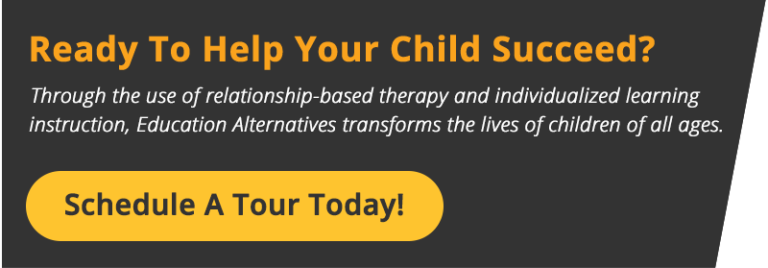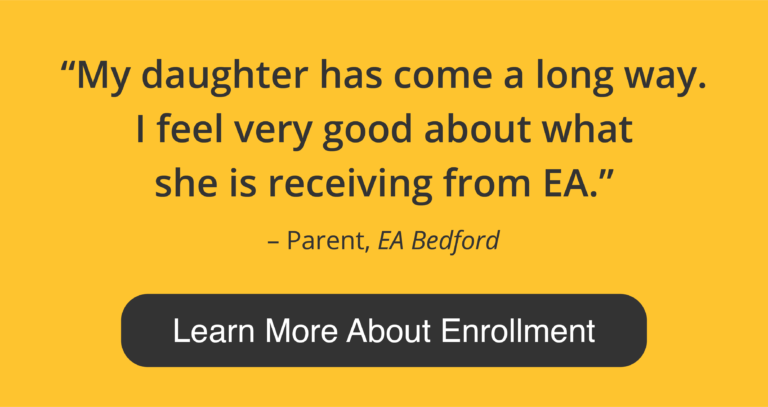We all know how important education is for our children. It’s the thing that prepares them for life and helps them grow into their full potential.
But as a parent of a child with autism, you’ll also know that kids with autism learn differently. And sometimes it can feel like they’re losing out simply because the system doesn’t understand them.
If this is how you feel, we have good news for you.
Because in fact, when it comes to education for autism, your child’s rights are clearly outlined, and there are strong legal protections in place to ensure they get the education that they both need and deserve, without you having to pay extra.
From federal laws that guarantee extra support at school, to separate special education facilities—like EA Schools—that are designed for kids with autism and other learning differences, and which are also covered by the state, there are plenty of options available to help ensure your child can thrive.
In this guide, we’ll walk you through the key rights your child with autism has at every stage of their education journey, so that you, as a parent, can understand all the help that’s available, and make sure your child is getting the support they are entitled to.

Education for autism: A quick glance summary of your child’s rights
In the US, every child has the right to a public education.
And for children with disabilities or learning differences—including autism—those rights go one step further: they have the right to an education that meets their individual needs, not just academically, but socially, emotionally, and practically.
The relevant legislation is called the Individuals with Disabilities Education Act, better known as “IDEA.”
We’ll go into more detail throughout this article, but here’s a quick overview.
If your child has autism, they are entitled to:
- A Free and Appropriate Public Education (FAPE) that meets their individual needs, at no cost to your family.
- Education in the Least Restrictive Environment (LRE), allowing them to learn alongside peers whenever possible.
- Access to Early Intervention (EI) Services (0–3), to support their development.
- An Individualized Education Program (IEP) (ages 3+), outlining their specific educational needs, goals, and required services.
- Transition planning for life after high school, including career readiness and independent living.
- Reasonable accommodations and supports to help them succeed in the classroom.
- Active participation from parents and guardians in all decisions about their education.
- A high-quality, inclusive education that supports their academic, social, and emotional growth.
Now, let’s dive deeper into what these rights mean, and how they apply at every stage of your child’s journey.
IDEA and autism: Understanding your child’s educational rights
The Individuals with Disabilities Education Act (IDEA) is the backbone of special education law in the United States.
It ensures that students with disabilities, including autism, receive the services and supports they need to succeed in school, at no additional cost to their families.
Your child’s key rights under IDEA include:
- FAPE (Free and Appropriate Public Education)
FAPE stands for Free and Appropriate Public Education. This means your child is entitled to an education, provided for by the state, that is tailored to their individual needs.
This might mean they are given additional help and support within a mainstream school setting, or that they will qualify for placement in an alternative education setting, like EA Schools.
- LRE (Least Restrictive Environment)
The Least Restrictive Environment (LRE) principle means that students with disabilities have the right to be educated alongside children without disabilities as much as possible, while still receiving the individualized support they need.
This usually means they’ll remain in a mainstream classroom, but with a one-on-one aide or other accommodations that will help them to succeed within the general education setting.
However, it’s important to remember that the “least restrictive” setting won’t be the same for every child. For some students, a smaller specialized program, like those offered at EA Schools, may actually provide the best opportunity for growth, inclusion, and success.
Special educational services for kids with autism—by age group
The above points outline your child’s right to a personalized, supportive education, which remain the same throughout their education.
However, as your child grows, their needs change, and this includes the type of extra support or accommodations they may need.
Here’s how the Special Education Services offered for children with autism differ at each stage of their journey.
Early Intervention (EI) Services (ages 0–3)
Although children under three aren’t yet at school, if they are diagnosed with autism (or other eligible conditions) during these early years, there are Early Intervention (EI) Services that they can access under the IDEA framework, which are also covered by the state.
EI Services are focused on helping your child’s development, so might include speech and language therapy, occupational therapy, Applied Behavior Analysis (ABA), and more.
The starting point to accessing these services is an official document called the Individualized Family Service Plan (IFSP). The IFSP outlines your child’s current developmental levels, family goals, and the services your child and family will receive.
Early intervention can make a significant difference in building communication, social, and daily living skills—laying the foundation for success in school and beyond.
Special Education Services and IEPs (ages 3–18)
Once a child turns three, educational support shifts to school-based Special Education Services, and is all handled via the school district.
The focus also moves from supporting your child’s overall development to being specific to their educational needs.
A key part of this process is creating an Individualized Education Program (IEP).
An IEP is similar to an IFSP, but specific to your child’s education. It is a legal document that will outline the exact services and accommodations they need to receive, including whether these will be in a mainstream setting or an alternative education environment, like the CORAL Autism Program at EA Schools.
IEPs are created collaboratively between your child’s teachers, the school district, and you—the parent or guardian, and are one of the most important aspects of an autistic child’s education.
Once the IEP is developed, the school district must provide all agreed-upon services at no cost to your family. Depending on your child’s needs, this might include:
- Assistive technology (e.g., communication devices, speech-to-text software, visual supports)
- Specialized instruction (customized teaching methods)
- Therapies such as speech therapy and occupational therapy
- Behavioral support plans (strategies to help manage behavior at school)
- Accommodations and classroom modifications (like extra time on tests, sensory breaks, or visual schedules)
- Social skills support (structured activities to build communication and interaction skills)
- Placement decisions (mainstream classroom, resource room, or specialized settings like EA Schools’ CORAL Autism Program)
All of these services are designed to meet your child’s unique educational needs, helping them learn, grow, and succeed in the best way for them.
Find out more about IEPs, and how to get one for your child.
Transition Services for young adults (ages 14–21)
Starting around age 14–16, Transition Services are added to the IEP to prepare young adults for life after high school.
The focus includes career readiness, independent living skills, post-secondary education, and self-advocacy.
Transition planning is a key part of education for autism, and another of your child’s rights under IDEA. However, it’s important to realize that funding for Transition Services under IDEA are only available while a student is in the school system, ending when they graduate or age out (usually between ages 18 and 21). So it’s crucial to set these services up as early as possible.
At EA Schools, our Vision Quest program supports young adults with autism in developing real-world skills, exploring career options, building independence, and preparing for meaningful, fulfilling futures.

Your role as a parent in advocating for your child’s rights
One of the most important rights protected under IDEA is for you as a parent or guardian to actively participate in your child’s education.
Parents are often the most powerful advocates, so it’s vital to understand the role you can play.
As a parent or guardian, you have the right to:
- Be a part of the team developing your child’s IEP.
- Participate in all meetings where your child’s identification, evaluation, educational placement, and services are discussed.
- Access all of your child’s educational records, including evaluations, reports, and communication.
- Advocate for services, supports, and accommodations you believe are necessary.
Schools are required to seek out your input, listen to your concerns, and work with you—not just inform you—when making decisions about your child’s education.
Remember—you know your child better than anyone, and your insights about their strengths, needs, and goals are vital to creating the most effective educational plan.
It’s also important to remember that although IDEA ensures the provisions are in place to support your child, deciding on the “appropriate” services and supports will depend both on your child’s unique needs and the people involved in that conversation.
As a parent, you have the right—and the opportunity—to fight for what you know your child needs.
How to access the Special Education Services your child is entitled to
Navigating Special Education Services can feel overwhelming at first, but there are clear steps to help you access the support your child needs and is entitled to.
If your child is under three, you should contact your local Early Intervention Agency. They will guide you through the process of evaluation and setting up services through an Individualized Family Service Plan (IFSP).
If your child is three or older, services are coordinated through your local school district. Start by speaking with their current school or teacher, who can guide you on how to begin the process—including requesting an evaluation and developing an IEP if your child qualifies.
If you are interested in your child attending EA Schools, there are two possible routes to enrollment:
- If their IEP recommends an alternative school setting, they will automatically qualify for enrollment at EA Schools, with tuition covered by the school district.
- If their IEP does not recommend an alternative setting, your child may still qualify under the Autism Scholarship Program. Contact us, and we will walk you through the eligibility criteria and help you with every step of the application process.
Remember, you are not alone—our team at EA Schools is here to help you navigate your options and find the right educational path for your child’s success.
Every child deserves an education that fits their needs
Children with autism have the right to a high-quality education that respects their unique needs, encourages their individuality, builds their strengths, and prepares them for a fulfilling life.
Understanding your child’s rights and knowing the options available are the first important steps to getting them the education they need.
At EA Schools, we’re passionate about ensuring every child receives the education and support they deserve.
If you’re ready to learn more about our specialized programs or need help navigating your child with autism’s educational rights, contact us today. We’re here to support you at every step of the journey.
